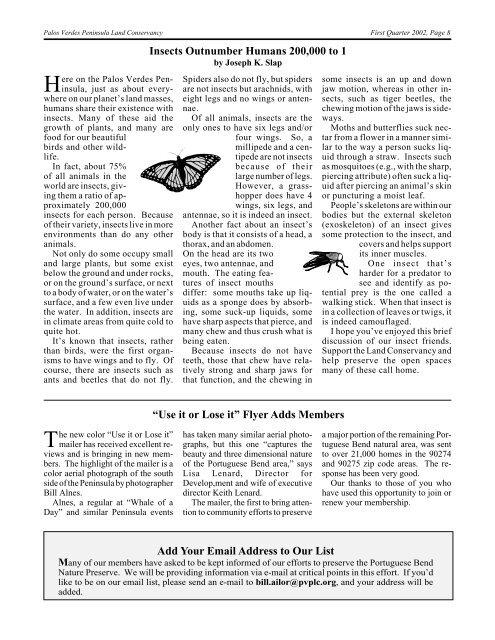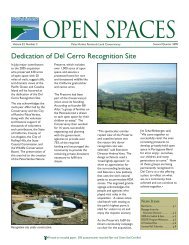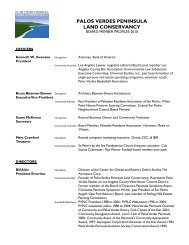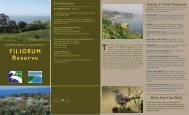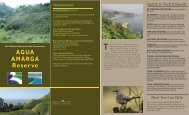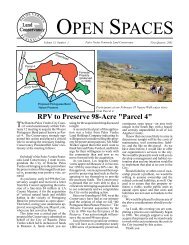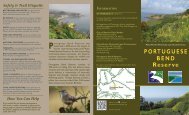OPEN SPACES - Palos Verdes Peninsula Land Conservancy
OPEN SPACES - Palos Verdes Peninsula Land Conservancy
OPEN SPACES - Palos Verdes Peninsula Land Conservancy
Create successful ePaper yourself
Turn your PDF publications into a flip-book with our unique Google optimized e-Paper software.
<strong>Palos</strong> <strong>Verdes</strong> <strong>Peninsula</strong> <strong>Land</strong> <strong>Conservancy</strong><br />
Here on the <strong>Palos</strong> <strong>Verdes</strong> <strong>Peninsula</strong>,<br />
just as about everywhere<br />
on our planet’s land masses,<br />
humans share their existence with<br />
insects. Many of these aid the<br />
growth of plants, and many are<br />
food for our beautiful<br />
birds and other wildlife.<br />
In fact, about 75%<br />
of all animals in the<br />
world are insects, giving<br />
them a ratio of approximately<br />
200,000<br />
insects for each person. Because<br />
of their variety, insects live in more<br />
environments than do any other<br />
animals.<br />
Not only do some occupy small<br />
and large plants, but some exist<br />
below the ground and under rocks,<br />
or on the ground’s surface, or next<br />
to a body of water, or on the water’s<br />
surface, and a few even live under<br />
the water. In addition, insects are<br />
in climate areas from quite cold to<br />
quite hot.<br />
It’s known that insects, rather<br />
than birds, were the first organisms<br />
to have wings and to fly. Of<br />
course, there are insects such as<br />
ants and beetles that do not fly.<br />
The new color “Use it or Lose it”<br />
mailer has received excellent reviews<br />
and is bringing in new members.<br />
The highlight of the mailer is a<br />
color aerial photograph of the south<br />
side of the <strong>Peninsula</strong> by photographer<br />
Bill Alnes.<br />
Alnes, a regular at “Whale of a<br />
Day” and similar <strong>Peninsula</strong> events<br />
Insects Outnumber Humans 200,000 to 1<br />
by Joseph K. Slap<br />
Spiders also do not fly, but spiders<br />
are not insects but arachnids, with<br />
eight legs and no wings or antennae.<br />
Of all animals, insects are the<br />
only ones to have six legs and/or<br />
four wings. So, a<br />
millipede and a centipede<br />
are not insects<br />
because of their<br />
large number of legs.<br />
However, a grasshopper<br />
does have 4<br />
wings, six legs, and<br />
antennae, so it is indeed an insect.<br />
Another fact about an insect’s<br />
body is that it consists of a head, a<br />
thorax, and an abdomen.<br />
On the head are its two<br />
eyes, two antennae, and<br />
mouth. The eating features<br />
of insect mouths<br />
differ: some mouths take up liquids<br />
as a sponge does by absorbing,<br />
some suck-up liquids, some<br />
have sharp aspects that pierce, and<br />
many chew and thus crush what is<br />
being eaten.<br />
Because insects do not have<br />
teeth, those that chew have relatively<br />
strong and sharp jaws for<br />
that function, and the chewing in<br />
“Use it or Lose it” Flyer Adds Members<br />
has taken many similar aerial photographs,<br />
but this one “captures the<br />
beauty and three dimensional nature<br />
of the Portuguese Bend area,” says<br />
Lisa Lenard, Director for<br />
Develop,ment and wife of executive<br />
director Keith Lenard.<br />
The mailer, the first to bring attention<br />
to community efforts to preserve<br />
First Quarter 2002, Page 8<br />
some insects is an up and down<br />
jaw motion, whereas in other insects,<br />
such as tiger beetles, the<br />
chewing motion of the jaws is sideways.<br />
Moths and butterflies suck nectar<br />
from a flower in a manner similar<br />
to the way a person sucks liquid<br />
through a straw. Insects such<br />
as mosquitoes (e.g., with the sharp,<br />
piercing attribute) often suck a liquid<br />
after piercing an animal’s skin<br />
or puncturing a moist leaf.<br />
People’s skeletons are within our<br />
bodies but the external skeleton<br />
(exoskeleton) of an insect gives<br />
some protection to the insect, and<br />
covers and helps support<br />
its inner muscles.<br />
One insect that’s<br />
harder for a predator to<br />
see and identify as potential<br />
prey is the one called a<br />
walking stick. When that insect is<br />
in a collection of leaves or twigs, it<br />
is indeed camouflaged.<br />
I hope you’ve enjoyed this brief<br />
discussion of our insect friends.<br />
Support the <strong>Land</strong> <strong>Conservancy</strong> and<br />
help preserve the open spaces<br />
many of these call home.<br />
a major portion of the remaining Portuguese<br />
Bend natural area, was sent<br />
to over 21,000 homes in the 90274<br />
and 90275 zip code areas. The response<br />
has been very good.<br />
Our thanks to those of you who<br />
have used this opportunity to join or<br />
renew your membership.<br />
Add Your Email Address to Our List<br />
Many of our members have asked to be kept informed of our efforts to preserve the Portuguese Bend<br />
Nature Preserve. We will be providing information via e-mail at critical points in this effort. If you’d<br />
like to be on our email list, please send an e-mail to bill.ailor@pvplc.org, and your address will be<br />
added.


